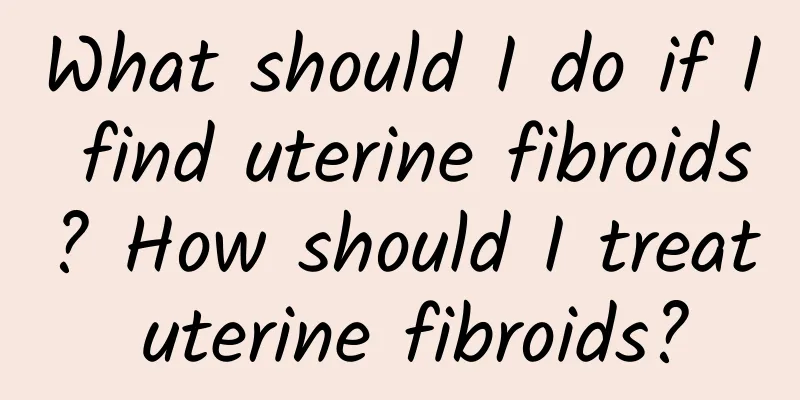What should I do if I find uterine fibroids? How should I treat uterine fibroids?

|
Uterine fibroids are more common in today's society, and many unmarried women also suffer from this disease. Although uterine fibroids are benign tumors, due to the harm to women, women should still pay attention to the prevention and treatment of the disease. So, how to detect uterine fibroids? The following is a detailed introduction. If uterine fibroids are found, they should be treated promptly. If not treated promptly, they may continue to grow and degenerate. Specific treatment methods are as follows: 1. Continued observation: If the fibroids are small and asymptomatic, generally no treatment is required, especially for patients near menopause. Due to low estrogen, the fibroids can shrink or disappear naturally, and follow-up can be done every 3-6 months. If the uterine fibroids increase in size or symptoms are obvious, please consider further treatment. 2. Drug treatment: For patients with fibroids within the size of a 2-month pregnant uterus, mild or mild symptoms, near menopause and general condition that cannot be operated on, symptomatic drug treatment can be used. (1) Androgens: They counteract estrogen, cause endometrial atrophy, and directly act on smooth muscle to cause contraction, reduce bleeding, and cause premature menopause in near-menopausal patients. Commonly used drugs: 5 mg of methyltestosterone, sublingually, twice a day, 20 days a month; or 25 mg of testosterone propionate, injected intramuscularly, once a day, 3 times in total, with a monthly total of no more than 300 mg, to avoid virilization. (2) Anti-estrogen preparations: Tamoxifen can be used to treat significantly increased menstruation and fibroid size such as pregnancy less than 2 months, 10 mg orally twice a day for 3-6 months. After use, menstruation is significantly reduced and fibroids can also be reduced, but they can gradually increase after stopping the drug. Side effects are menopausal syndrome, such as hot flashes, impatience, sweating, vaginal dryness, etc., and there may also be amenorrhea and a small amount of irregular vaginal bleeding. (3) Luteinizing hormone-releasing hormone (LHRH) analogs: LHRH analogs can inhibit pituitary and ovarian function, reduce estrogen levels, and treat small fibroids (≤ 2 months of gestational uterus), increased menstrual volume or shortened cycles, and menopausal or postmenopausal patients. LHRH-A 300 micrograms or 500 micrograms, used continuously for 3-6 months. Side effects of tamoxifen. 3. Surgical treatment: If the fibroids are larger than a 2.5-month pregnancy or the symptoms are obvious, surgical treatment is often required if secondary anemia occurs. Through the above content, we know what to do if you have uterine fibroids. It can be seen that there are many treatment methods and patients do not have to worry too much. However, this disease should be treated early, especially for infertile women. The treatment method should be chosen carefully. In addition, some things need to be paid attention to during the treatment, such as eating a light diet, paying attention to rest, etc. |
>>: What should women do if they have uterine fibroids? Are uterine fibroids benign tumors?
Recommend
Specific diet method after suffering from adnexitis
Many patients who have adnexitis do not know what...
Can I eat mung beans if I have pelvic inflammatory disease? But don’t eat it for a long time
Many women with pelvic inflammatory disease are p...
Will you gain weight just by drinking cold water? Press these 4 acupoints to help you lose weight quickly
"You'll gain weight even if you drink a ...
Who are the people with high risk of cervical erosion?
The prevention of cervical erosion needs to attra...
Do chubby girls often have uterine fibroids? Zhou Zonghan: Drink 1 weight loss tea to get rid of phlegm and dampness
What? Excessive body fat may actually contribute ...
Treatment of vaginal candidiasis
Treatment of vaginal candidiasis: If candidal vag...
How to treat and regulate pelvic effusion
The treatment of pelvic effusion is a question th...
How to diagnose female cervical erosion? Can cervical erosion be diagnosed? Recommended Chinese medicine treatment methods
How to diagnose cervical erosion? Nowadays, cervi...
How long does it usually take for abdominal pain to occur during an ectopic pregnancy? You need to analyze it based on your own situation.
The specific location of the ectopic pregnancy is...
What is the reason for irregular menstruation?
Women who have irregular menstruation need to rec...
Have you ever paid attention to the clinical manifestations of uterine fibroids?
Do you know what the clinical manifestations of u...
Why is bacterial vaginosis contagious?
Vaginal candidiasis is a type of vaginitis, and i...
How much do you know about the precautions after an abortion?
What are the precautions after artificial abortio...
Try to find ways to treat adnexitis in your life
As a frequently-occurring disease, adnexitis will...
Do you know the symptoms of ovarian cysts?
What are the symptoms of ovarian cysts? Ovarian t...









